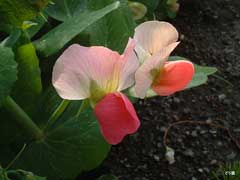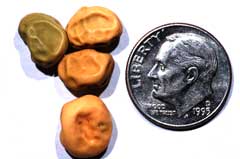 |
|
http://photozou.jp/photo/show/110033/19577543 |
 |
| http://commons.wikimedia.org/wiki/User:Ninjatacoshell |
Translate this page:
Summary
Physical Characteristics

 Pisum sativum arvense is a ANNUAL growing to 2 m (6ft 7in).
Pisum sativum arvense is a ANNUAL growing to 2 m (6ft 7in).
It is not frost tender. It is in flower from May to September, and the seeds ripen from July to October. The species is hermaphrodite (has both male and female organs) and is pollinated by Occasionally bees. The plant is self-fertile.
It can fix Nitrogen.
Suitable for: light (sandy) and medium (loamy) soils and prefers well-drained soil. Suitable pH: neutral and basic (mildly alkaline) soils. It cannot grow in the shade. It prefers moist soil.
UK Hardiness Map
US Hardiness Map
Synonyms
P. arvense.
Plant Habitats
Cultivated Beds;
Edible Uses
Edible Parts: Leaves Seed
Edible Uses:
Seed - cooked or sprouted and eaten raw[2, 46, 61]. A good source of protein. The seeds of this sub-species tend to be of poorer quality than the species, being less rich in sugars. They are grown mainly for use when mature and dried. Young leaves - cooked[177].
References More on Edible Uses
Medicinal Uses
Plants For A Future can not take any responsibility for any adverse effects from the use of plants. Always seek advice from a professional before using a plant medicinally.
Contraceptive Skin
The seed is contraceptive, fungistatic and spermacidal[218]. The dried and powdered seed has been used as a poultice on the skin where it has an appreciable affect on many types of skin complaint including acne[7]. The oil from the seed, given once a month to women, has shown promise of preventing pregnancy by interfering with the working of progesterone[218]. The oil inhibits endometrial development[240]. In trials, the oil reduced pregnancy rate in women by 60% in a 2 year period and 50% reduction in male sperm count was achieved[240].
References More on Medicinal Uses
The Bookshop: Edible Plant Books
Our Latest books on Perennial Plants For Food Forests and Permaculture Gardens in paperback or digital formats.

Edible Tropical Plants
Food Forest Plants for Hotter Conditions: 250+ Plants For Tropical Food Forests & Permaculture Gardens.
More

Edible Temperate Plants
Plants for Your Food Forest: 500 Plants for Temperate Food Forests & Permaculture Gardens.
More

More Books
PFAF have eight books available in paperback and digital formats. Browse the shop for more information.
Shop Now
Other Uses
Green manure
Sometimes grown as a spring sown green manure, plants produce a good bulk and fix a large quantity of nitrogen[46, 87].
Special Uses
Nitrogen Fixer
References More on Other Uses
Cultivation details
Requires a well-drained moisture retentive soil[1, 16, 37]. Prefers a calcareous soil[37]. Prefers a rich loamy soil[1]. A light soil and a sheltered position is best for early sowings[1]. This a more vigorous form of P. sativum with less sweet seeds which are usually eaten as a protein crop when they are mature. This sub-species is taken to include the Maple peas with varieties such as Minerva and Marathon[87]. Other varieties included in this group are 'Bavarian pea', 'Black-podded pea', East Prussian pea', Sand pea', Smyrna pea' and 'Konigsberger pea'[61]. This species has a symbiotic relationship with certain soil bacteria, these bacteria form nodules on the roots and fix atmospheric nitrogen. Some of this nitrogen is utilized by the growing plant but some can also be used by other plants growing nearby[200]. When removing plant remains at the end of the growing season, it is best to only remove the aerial parts of the plant, leaving the roots in the ground to decay and release their nitrogen.
References Carbon Farming Information and Carbon Sequestration Information
Temperature Converter
Type a value in the Celsius field to convert the value to Fahrenheit:
Fahrenheit:
The PFAF Bookshop
Plants For A Future have a number of books available in paperback and digital form. Book titles include Edible Plants, Edible Perennials, Edible Trees,Edible Shrubs, Woodland Gardening, and Temperate Food Forest Plants. Our new book is Food Forest Plants For Hotter Conditions (Tropical and Sub-Tropical).
Shop Now
Plant Propagation
Pre-soak the seed for 12 hours in warm water and sow it in situ from early to late spring. Germination should take place within 2 weeks.
Other Names
If available other names are mentioned here
Native Range
Coming Soon
Weed Potential
Right plant wrong place. We are currently updating this section.
Please note that a plant may be invasive in one area but may not in your area so it's worth checking.
Conservation Status
IUCN Red List of Threatened Plants Status :

Growth: S = slow M = medium F = fast. Soil: L = light (sandy) M = medium H = heavy (clay). pH: A = acid N = neutral B = basic (alkaline). Shade: F = full shade S = semi-shade N = no shade. Moisture: D = dry M = Moist We = wet Wa = water.
Now available:
Food Forest Plants for Mediterranean Conditions
350+ Perennial Plants For Mediterranean and Drier Food Forests and Permaculture Gardens.
[Paperback and eBook]
This is the third in Plants For A Future's series of plant guides for food forests tailored to
specific climate zones. Following volumes on temperate and tropical ecosystems, this book focuses
on species suited to Mediterranean conditions—regions with hot, dry summers and cool, wet winters,
often facing the added challenge of climate change.
Read More
Expert comment
Author
(L.)Poir.
Botanical References
1750
Links / References
For a list of references used on this page please go here
Readers comment
| Add a comment |
|
If you have important information about this plant that may help other users please add a comment or link below. Only comments or links that are felt to be directly relevant to a plant will be included. If you think a comment/link or information contained on this page is inaccurate or misleading we would welcome your feedback at [email protected]. If you have questions about a plant please use the Forum on this website as we do not have the resources to answer questions ourselves.
* Please note: the comments by website users are not necessarily those held by PFAF and may give misleading or inaccurate information.
To leave a comment please Register or login here All comments need to be approved so will not appear immediately.
|
Subject : Pisum sativum arvense
|
|
|
|